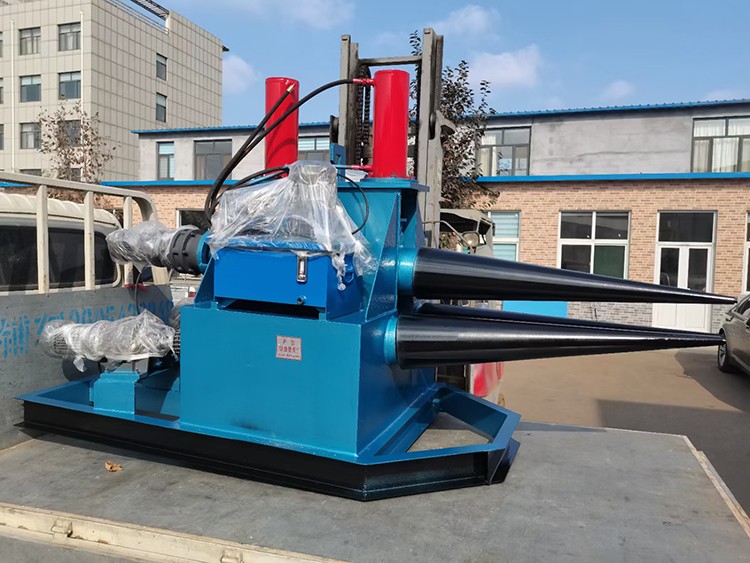

We are a professional cone rolling machine manufacturer with over 10 years of industry experience. Today, we would like to introduce to you the common faults and solutions of cone rolling machine:

Cone rolling machine is an important equipment in sheet metal processing, mainly used for making conical and curved workpieces. In actual use, due to operation, maintenance or equipment itself, some common failures may occur, affecting processing efficiency and product quality. We will list several typical failures, analyze their possible causes, and provide the corresponding solutions.
1, Rolled workpiece bulging or concave
The surface of the rolled workpiece is uneven, localized bulging or depression, affecting subsequent welding or assembly.
(1)Uneven roller pressure, resulting in unbalanced plate force.
(2)Uneven plate thickness or internal stress.
(3)Roller wear or deformation, resulting in contact with the plate does not match.
(1)Adjust the roller pressure to ensure that the force on each roller is uniform.
(2)Check the quality of the plate and avoid using materials with obvious defects.
(3)Regularly check the wear and tear of the rollers and repair or replace them if necessary.
2, Rolled taper inaccuracy
The taper of the rolled workpiece does not match the set value, resulting in dimensional deviation.
(1)Incorrect setting of equipment parameters, such as improper adjustment of feed speed and roll angle.
(2)Sheet sliding, resulting in positional shift during the rolling process.
(3)Control system error, such as encoder or servo motor feedback abnormality.
(1)Recalibrate the device parameters to ensure that the input data is correct.
(2)Check the plate fixing device and add anti-slip measures (e.g. compression mechanism).
(3)Check the electrical system and contact the manufacturer for servo parameter optimization if necessary.
3, Abnormal vibration or noise in the operation of the equipment
Cone rolling machine produces obvious vibration or abnormal noise during operation, affecting the processing stability.
(1)Wear and tear of mechanical transmission parts, such as damaged gears, bearings or couplings.
(2)Poorly fixed equipment base, causing resonance.
(3)Unstable hydraulic system pressure, causing shock vibration.
(1)Check the transmission parts and replace parts that are badly worn.
(2)Reinforce the foundation of the equipment to ensure that the machine is installed smoothly.
(3)Troubleshoot the hydraulic system, adjust the pressure valve or replace the hydraulic oil.
4, Plate running off or feeding is not smooth
The plate deviates from the predetermined trajectory in the process of rolling, or jams when feeding.
(1)Guide wheel is not properly adjusted, resulting in poor sheet centering.
(2)Insufficient pressure on the feed rollers, resulting in slippage of the sheet.
(3)Too many burrs on the edge of the sheet, preventing smooth feeding.
(1) Adjust the position of the guide wheel to ensure that the sheet is centered into the rollers.
(2) Increase feed roll pressure or check for proper air pressure/hydraulic system.
(3) Deburr the sheet before rolling.
5, Insufficient pressure in the hydraulic system
The Cone rolling machine operates slowly or fails to reach the set pressure, affecting the rolling effect.
(1)Insufficient hydraulic oil or oil deterioration.
(2)Wear and tear of the oil pump, oil supply pressure drops.
(3)Hydraulic valve clogged or leaking.
(1)Check oil level and replenish or replace hydraulic oil.
(2)Test oil pump performance and repair or replace if necessary.
(3)Clean or replace the defective hydraulic valve and check line sealing.
6, Electrical control system failure
The equipment can not start, operation failure or display abnormal alarm.
(1)Poor contact or short circuit in the control line.
(2)PLC or servo drive parameter error.
(3)Sensor (e.g. limit switch) failure.
(1)Check electrical wiring and tighten loose parts.
(2)Restore factory parameters or recalibrate the control system.
(3)Test the sensor signal and replace the faulty component.
7, After rolling the workpiece rebound is too large
Obvious rebound occurs after the workpiece is unloaded, resulting in the final shape does not meet the requirements.
(1)More elastic material (e.g., high-strength steel), requiring greater plastic deformation.
(2)Rolling pressure is not enough to fully overcome the material rebound.
(3)Rolling speed is too fast, the material is not fully formed.
(1)Increase the roll pressure appropriately, or use multiple progressive rolls.
(2)Reduce the rolling speed so that the material is fully deformed.
(3)Special materials can be preheated to minimize springback.
Failures of cone rolling machine are usually related to mechanical adjustments, hydraulic systems, electrical controls or operating practices. Regular maintenance, correct operation and timely troubleshooting can effectively reduce the occurrence of failures. If the problem is beyond the scope of daily handling, it is recommended to contact professional technicians or equipment manufacturers for overhaul to avoid blind disassembly leading to greater damage.
If you are interested in cone rolling machine, please contact us.
 Address:Room 1202, Detaitang Building, No. 118 Huaguang Road, Zhangdian District, Zibo, Shandong
Address:Room 1202, Detaitang Building, No. 118 Huaguang Road, Zhangdian District, Zibo, Shandong WhatsApp:+8615653328535
WhatsApp:+8615653328535 Wechat: +8615965331535
Wechat: +8615965331535  E-mail:zs@sdsmachinery.com
E-mail:zs@sdsmachinery.com